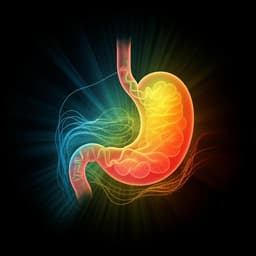
Veterinary Science
A novel modelling approach to quantify the response of dairy goats to a high-concentrate diet
M. Taghipoor, M. Delattre, et al.
This groundbreaking study by Masoomeh Taghipoor, Maud Delattre, and Sylvie Giger-Reverdin introduces a novel modeling approach to assess the resilience of dairy goats adapting to high-concentrate diets. By examining rumen pH kinetics, the research reveals the intriguing variability in individual goat responses and provides insights for optimizing feeding strategies in precision livestock farming.
~3 min • Beginner • English
Introduction
Sub-acute ruminal acidosis (SARA) is a frequent consequence of high-concentrate, rapidly fermentable diets in high-producing ruminants, depressing cellulolysis and dry matter intake when rumen pH falls near or below ~6.0. Within a herd, some animals are susceptible to SARA while others are tolerant, yet there has been no quantitative, individual-level index of the rumen acid status response. The authors aim to develop a modelling approach that assigns each goat a daily score and a single global index capturing its adaptive response to a sudden increase in dietary concentrate. The study uses dairy goats (Alpine or Saanen) with rumen pH as the indicator, measured at two embedded time scales (post-prandial hours within days, and across multiple weeks). The working hypothesis is that goats can regulate rumen pH in the short term, whereas sustained exposure to a high-concentrate diet may degrade this capacity over the longer term. Because pH statistics can be problematic, analyses are based on hydrogen ion concentration [H+] (pH = −log10[H+]).
Literature Review
The paper situates SARA as a well-documented problem affecting feed efficiency and production, with numerous proposed indicators (initial/final pH, amplitude, area/time under thresholds). However, prior work lacked a quantitative index summarizing individual animals’ adaptive response. Related studies have modelled responses to diverse perturbations (feed restriction, weaning, mycotoxins), typically using indicators measured at a single time scale. The authors also draw on the health trajectories framework, previously used to analyze resistance and tolerance to infection by plotting pathogen load versus performance and assigning temporal scores. The present study adapts this concept to a response–response phase-plane for rumen acidity descriptors. The work aligns with broader efforts to phenotype robustness and resilience in livestock for selection and precision feeding, and with calls to identify non-invasive biomarkers of adaptive capacity.
Methodology
Ethics and setting: Procedures complied with French and European regulations (COMETHEA 45, 15-04). The study ran from mid-April to mid-May 2015 at INRAE-AgroParisTech MOSAR (Thiverval-Grignon, France). Animals and diets: Eight rumen-cannulated dairy goats (4 Alpine, 4 Saanen) were habituated to a total mixed ration (TMR) with 20% concentrate (DM basis), then abruptly switched to 50% concentrate. Diets were iso-protein (INRA system). Goats were fed to requirement with ~13% refusals on average; TMR minimized sorting. Feeding occurred after milking at 07:00 and 15:00 (1/3 AM, 2/3 PM). Sampling design: Rumen fluid was sampled via cannula before and 1, 2, 4, and 6 h after morning feeding on 9 days: two pre-change (d1, d2 = d1+3), four consecutive post-change (d3–d6), and weekly thereafter (d7 = d6+4; d8 = d7+6; d9 = d8+7). Rumen pH measured immediately. Diet samples collected on the 9 rumen-sampling days and analyzed for DM, NDF (modified Van Soest), ADF, ADL, starch (AFNOR 1997), and crude protein (Dumas N × 6.25); nutritive value per INRA system. Data transformation: pH values were transformed to [H+] (moles/L) for modelling and statistical tests. Three-step modelling procedure: Step 1 (synthetic variables): Post-prandial [H+] kinetics per day were fitted with a quadratic function re-parameterized to biologically meaningful parameters v0, A, and R: v0 = initial [H+] before morning feeding; A = amplitude of acidosis (max[H+] − v0); R = recovery capacity at 6 h post-feeding. Additional derived variables considered included duration under an acidity threshold θ (dur), amplitude over θ (AmpAc), and [H+] at 6 h (Vlast). To avoid dependence on the choice of θ (5.5–6.0 in literature), analyses focused on v0, A, R (θ-independent). Step 2 (mixed models for time effects): For each synthetic variable, a linear mixed model tested short-term (within-week) and long-term (across weeks) effects: Vijk = αj + Gi + βj(daysk·1j=2) + εijk, with goat i as random intercept (Gi ~ N(0, σG2)), week j (W1 standard diet, W2–W5 high-concentrate) as fixed categorical effect (αj), and days (numeric) as a fixed effect applied only in week 2 (βj with indicator 1j=2). Residuals εijk ~ N(0, σ2). Box-Cox power transformations were applied when needed; residual normality and heteroscedasticity were checked. Step 3 (adaptive capacity scoring): For variables with significant long-term effects (v0 and A), daily scores si,i+1 in {−2, −1, 1, 2} were assigned based on direction of change between sampling days in the v0–A phase plane: decreases in both (2), increases in both (−2), v0↑ with A↓ (1), v0↓ with A↑ (−1). Scores were weighted by relative Euclidean distance between consecutive days, scaled by the interval length: ωi,i+1 = (1/√Δt)·√((ΔA)2 + (Δv0)2). The daily index di,i+1 = si,i+1·ωi,i+1 and the global index GI is the sum over intervals from d2→d3 through d8→d9 (first diet-change day is d3). Statistical analyses: R 3.5.3 was used. Non-Gaussianity addressed with Box-Cox; mixed models via lme4; fixed effects evaluated by likelihood ratio tests (ANOVA), with FDR-adjusted post hoc comparisons (emmeans). Spearman correlations described relationships among synthetic variables; Shapiro–Wilk tested normality. A parallel analysis directly on pH-derived synthetic variables was performed for comparison with [H+].
Key Findings
- Rumen acidity range and health: No apparent health problems; rumen pH ranged from 5.29 to 7.07 across the trial.
- Correlations among synthetic variables (n=72 day-level profiles): A and AmpAc were strongly positively correlated (r=0.89). The quadratic curvature parameter a was strongly negatively correlated with A (r=−0.96) and AmpAc (r=−0.90). θ-dependent variables (AmpAc, dur) varied with threshold choice, motivating focus on θ-independent v0, A, R.
- Mixed-model time effects (on power-transformed variables): v0 and A showed significant week effects (p<0.001 for both), but no significant short-term day effect within Week 2 (p=0.11). Recovery capacity R had no significant effects of week or days. Patterns suggested minimal change up to Week 4, with increases by Week 5.
- Variance partitioning (ρ = σG2/(σG2+σr2)): v0 showed high between-goat variability (ρ=0.56), A moderate (ρ=0.17), and R low (ρ=0.10), indicating strong individual differences in basal rumen acid status and moderate differences in within-day amplitude.
- Adaptive capacity indices: Using v0 and A phase trajectories, all goats had negative global indices over the period; six goats had relatively larger (less negative) global indices (>−10), while two had small indices (<−20). Goat 8 had the best adaptive response (least negative global index), and Goat 1 the poorest. Two main adaptive strategies emerged: (i) minimizing variation magnitudes (smaller Euclidean steps; e.g., Goats 8, 2, 6), and (ii) oscillatory changes, notably in A (e.g., Goats 3, 5).
- pH-based analysis vs [H+]: For pH-derived variables, initial pH (V0) was significantly affected by week (χ2=72.7, p<0.001) and days (χ2=11.7, p<0.001), with 81% variance due to individual differences; A had a significant week effect (χ2=17.1, p<0.01), 38% variance due to individuals; R showed no effects and 9% individual variance. Differences highlight potential pitfalls in using pH directly for statistical modelling compared to [H+].
Discussion
The study addressed the challenge of quantifying individual goats’ capacity to adapt to a high-concentrate diet when measurements are made at two nested time scales. By re-parameterizing a simple quadratic model to yield biologically interpretable variables (v0, A, R), and then integrating them in a mixed-model framework, the authors isolated long-term (week) from short-term (days) effects. The absence of significant short-term effects on v0 and A indicates goats can regulate rumen acidity acutely after diet change, whereas significant week effects—especially by Week 5—suggest accumulating difficulty or altered steady-state. The strong between-goat variability in v0 and moderate variability in A point to meaningful individual differences in basal rumen conditions and within-day acid load responses, likely linked to microbiota composition, saliva buffering, rumen wall absorption, and feeding behavior. The phase-trajectory metric provided nuanced, day-by-day scoring and an integrative global index, revealing distinct adaptive strategies (stabilizing vs oscillatory) that a simple average pH would miss. These indices can be coupled with behavioral, digestive, and metabolic phenotypes to identify biomarkers of resilience and inform precision feeding and selection programs. The comparison with pH-derived analyses underscores that relying solely on pH in statistical models can bias inference; [H+] is a more appropriate scale for modelling and hypothesis testing. The framework is general and can be extended to multiple indicators to evaluate multi-performance resilience in breeding and management contexts.
Conclusion
This work introduces a three-step, generic modelling framework that transforms post-prandial [H+] kinetics into biologically meaningful synthetic variables, disentangles short- and long-term time effects with mixed models, and quantifies individual adaptive capacity using phase-trajectory scores and a global index. Applied to goats facing an abrupt increase in dietary concentrate, the approach revealed substantial between-animal variability, two main adaptive strategies, and significant long-term effects on basal acidity and within-day amplitude. The method supports phenotyping for robustness and precision nutrition and can be adapted to other health or performance indicators, other species, and perturbations with multiple sampling time scales. Future work should validate the indices in larger cohorts, standardize sampling intervals, integrate additional behavioral and metabolic measures, and explore multi-indicator, higher-dimensional phase spaces to inform selection for resilience.
Limitations
- Sample size was small (n=8), limiting statistical power for short-term (days) effects (~40% with 8 goats; projected ~70% with 20). Week effects were well powered.
- Unequal intervals between sampling days required a weighting assumption in the phase-trajectory metric; rankings differed between weighted and unweighted metrics for some goats, warranting cautious interpretation and trait-specific metric choice.
- The analysis focused on two θ-independent indicators (v0 and A); while advantageous for generality, it omits potentially informative θ-dependent measures, which are sensitive to threshold selection.
- The study did not jointly analyze complementary data (e.g., intake, rumination, microbiota), which are likely important to interpret mechanisms underpinning adaptive strategies.
- Results over five weeks suggest longer-term trends, but extended monitoring would better characterize sustained adaptation or deterioration.
Related Publications
Explore these studies to deepen your understanding of the subject.







